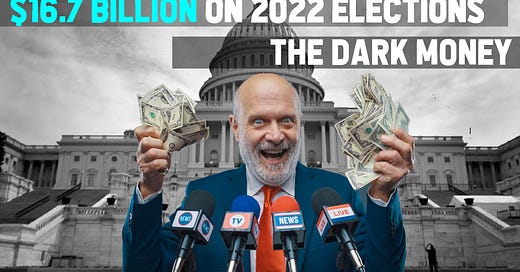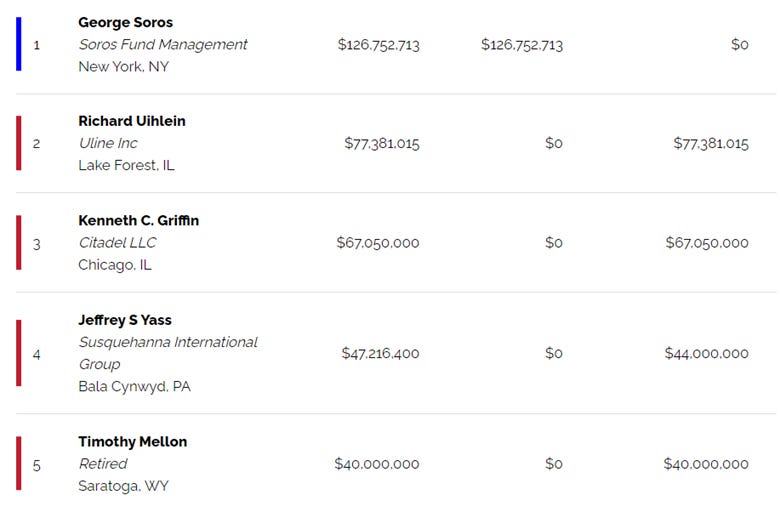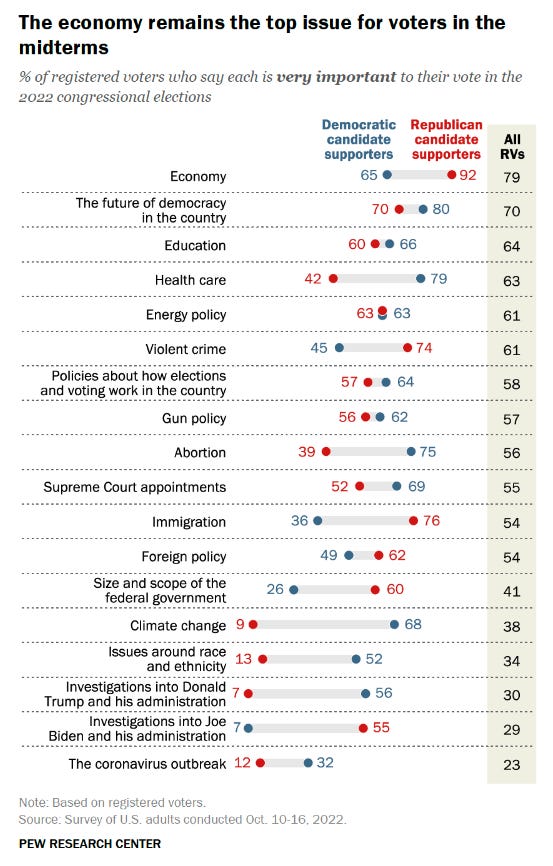The midterms $16.7 billion machine fueled by dark money
Corporate influence is is growing with every election cycle.
By: Zeynab Day
News and Opinion
Nearly everyone has received emails, text messages, and advertisements asking for donations for candidates and election groups, touting this election to be the most important in American history, and the pitch paying off for candidates and lobby firms.
The 2022 election cycle is estimated to rake in an outrageous $16.7 billion, according to the campaign finance tracking website Opensecrets.org.
To put this into perspective, the $16.7 billion equates to half of what the U.S. spends annually to combat domestic violence. The $16.7 billion is also greater than the annual budgets for federal parks and federal childcare programs combined. The amount of money raised for the 2022 elections even outsizes the $14.3 billion budget for the Federal Transit Administration.
The funds come from a myriad of sources with billionaires spending more than $880 million, Super PACs raising more than $2.26 billion and small-dollar donations accounting for nearly half of the money raised this election cycle.
The first two noted, billionaire and super PAC funding and expenditures are what are often referred to as “dark money.” Dark money denotes funds that are primarily undisclosed or campaign financing that can create an outsized corporate influence.
Dark money in today’s form hasn’t always been a component of American politics. It is a new phenomenon that has created increasing problems since its establishment a little more than a decade ago. Yet, we are seeing the impacts grow with each election cycle.
“Over the last decade, corporate spending continues to grow cycle-over-cycle, as does their influence on policy. The 2022 midterms have shown that campaign finance reform to end dark monied and corporate influence is fundamental to fair elections and democracy.”
So, what is dark money?
Super PACs, and hybrid PACs, are new on the American political landscape and only launched following two constitutive rulings by the U.S. Supreme court in 2010. This change in election law has skyrocketed election cycle funds and corporate influence on elections. Outside spending PACs (meaning outside of a campaign) can raise money from corporations, unions, and individuals with no limit, and are not required to disclose their donors, unlike other PACs such as Federal PACs and candidate PACs which have a limit of $5000 per election cycle that can be donated and must disclose donor information.
Super PACs are independent political action committees that can spend unlimited amounts of money to promote specific candidates or issues. According to the rules of the Federal Elections Commission (FEC) super PACs are restricted from working directly with electoral candidates and campaigns. However, super PACs can be launched to promote a specific candidate. Although super PACs are not permitted to work directly with campaigns there are limited checks in place to prevent coordination.
Hybrid PACs are also seen as outside spending dark-money PACs and can take unlimited funds from the same sources as super PACs, but hybrid PACs can donate directly to campaigns, unlike super PACs.
Many activists from across the political spectrum have warned of the undue corporate influence on current elections, with organizations such as the non-profit organization IssueOne who warn on their website that:
“Since the Supreme Court’s 2010 Citizens United decision opened the floodgates to unlimited election spending, big-money groups like super PACs and dark money organizations have had an alarming and growing influence. These groups routinely flout anti-corruption laws designed to prevent them from coordinating with candidates. All the while, secretive dark money groups — and even some super PACs — keep their donors hidden.”
Big spending in the 2022 midterms:
Open Secrets reported that, as of early November, super PACS have reported more than $2.26 billion in total receipts to the FEC, with expenditures exceeding $1.25 billion. Outside spending tops $1 billion for the 2022 midterms. This surpasses the $7o1.8 million of outside spending in the 2018 elections. Conservative groups have outspent liberal groups two to one in the 2022 cycle. A notable portion of expenditures was spent to promote five high-profile U.S. Senate races in Georgia, Pennsylvania, Nevada, Wisconsin, and Arizona.
Outside spending accounts for a whopping $130 million on the heated Pennsylvania Senate race between Lt. Gov. John Fetterman and Republican candidate Mehmet Oz alone, making it one of the highest amounts spent on a Congressional race in American history.
Billionaires are also hedging their bets with the top spender, George Soros, spending more than $125 million on Democratic elections, with Richard Uihlein, founder of Unline shipping and business supply company donating $77,381,015 to Republican candidates and organizations. According to Open Secrets, most of 75% of donations went directly to super PACs.
Billionaire spending supporting Republican races and candidates is twice that of spending on Democratic candidates and organizations as analysts anticipate a Republican minority in the U.S. Congress and state houses countrywide.
It’s important to note that spending by billionaires and corporations will often shift based on the party poised to win as they jostle for favor with the incoming majority to curry influence on legislation to benefit their bottom line.
Much of this funding goes to super PACs run by corporate lobbying firms for industries such as oil and gas, pharmaceuticals, entertainment, technology, and insurance firms.
(Source: Opensecrets.org “Who are the Biggest Donors?”)
What is it being spent on?
The influences of unchecked big money in politics account for many advertisements that permeate all media during election cycles, from television advertisements to social media ads and everything in between.
Much of the advertisements promoted by Democrats focus on abortion, elections protection, and Republicans. While Republican ads focus on culture war issues such as anti-LGBTQ rhetoric, patriotic education, elections distrust, and firearms ownership.
What is widely missing from the discourse is policies surrounding the economy, climate change, housing, infrastructure, and tabletop issues impacting families as the weight of inflated prices and suppressed wages place an increasing burden on households across the country. The narrative cultivated by the advertising backed by super PACs, corporations, and billionaires is out of sync with the issues at the forefront of voters’ minds. A Pew Research Institute Poll, released on November 3rd, shows that the economy is the top issue for voters that identify with both parties. Coming in second were education, healthcare, energy policy, and gun policy.
(Source: Pew Research Center, “Key facts about U.S. voter priorities ahead of the 2022 midterm elections”)
The Impact:
Billionaire and corporate influence on politics not only impacts the rhetoric regarding issues promoted during the election cycle but also has a mark on legislation our representatives pass once in office. Both the Democrat and Republican parties are influenced by the financing machines that fuel their elections and ensure they maintain a seat. The influences of corporations and billionaires have been attributed to massive corporate tax cuts, dismantling of unions, cuts to Medicaid, privatization of public entities such as prisons, and a bloated war budget.
Over the last decade, corporate spending continues to grow cycle-over-cycle, as does their influence on policy. The 2022 midterms have shown that campaign finance reform to end dark monied and corporate influence is fundamental to fair elections and democracy.
P.S. subscribe to get notifications about future Bullhorn Bulletin pieces including the next in this series: “The Bernie Boom: How $67 Million in small-dollar funds funneled into one marketing firm connected to Beto, Bernie, AOC, and the Justice Democrats.”
About: Zeynab Day, the founder of Bullhorn Bulletin, is an investigative journalist that has worked with more than 100 U.S. Congressional campaigns, led nationwide messaging projects for policy, and published more than 400 articles and pieces of content for candidates, news sites, and organizations. She has launched Bullhorn Bulletin to return to her investigative journalist roots in an effort to hold our representatives accountable, cover often overlooked news, and expose corruption in our systems of governance and society.








I can't wait to read this all the way through, Zana, but for now I'm just subscribing.